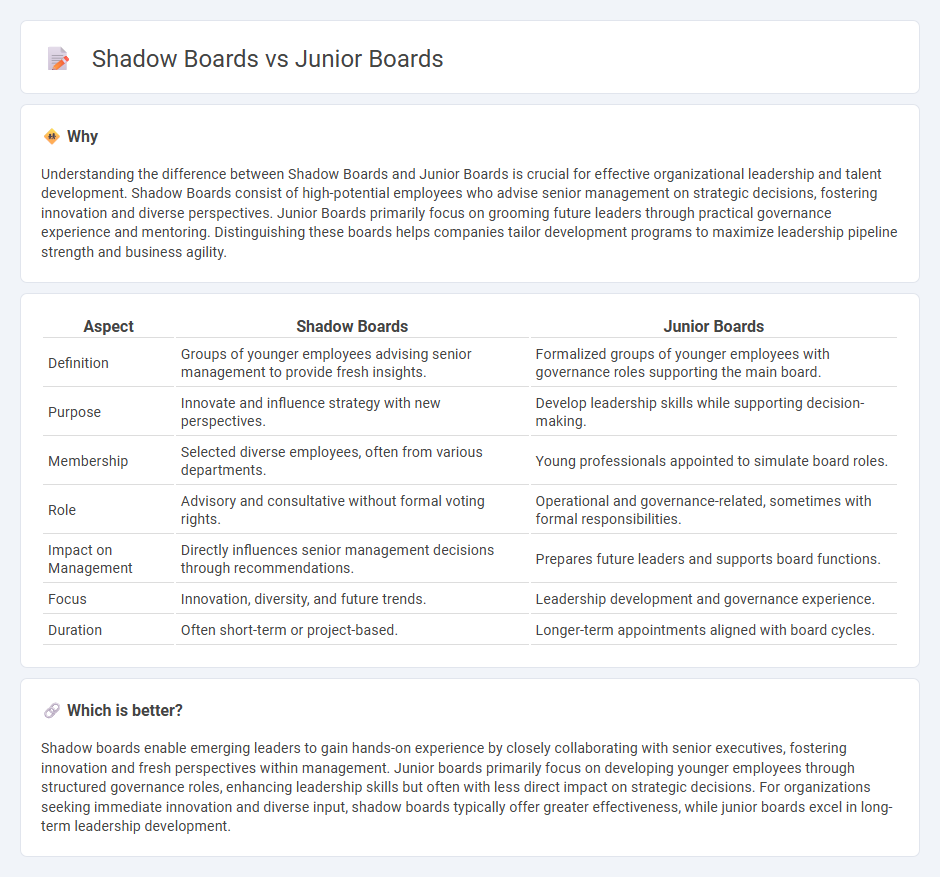
Shadow boards and junior boards involve younger employees participating in strategic decision-making processes within organizations, enhancing diversity and innovation. Shadow boards typically consist of employees who act as advisors to the senior management, providing fresh perspectives without formal decision-making power, whereas junior boards include emerging leaders who take on more active governance roles. Discover how integrating these boards can transform organizational leadership and drive business success.
Why it is important
Understanding the difference between Shadow Boards and Junior Boards is crucial for effective organizational leadership and talent development. Shadow Boards consist of high-potential employees who advise senior management on strategic decisions, fostering innovation and diverse perspectives. Junior Boards primarily focus on grooming future leaders through practical governance experience and mentoring. Distinguishing these boards helps companies tailor development programs to maximize leadership pipeline strength and business agility.
Comparison Table
| Aspect | Shadow Boards | Junior Boards |
|---|---|---|
| Definition | Groups of younger employees advising senior management to provide fresh insights. | Formalized groups of younger employees with governance roles supporting the main board. |
| Purpose | Innovate and influence strategy with new perspectives. | Develop leadership skills while supporting decision-making. |
| Membership | Selected diverse employees, often from various departments. | Young professionals appointed to simulate board roles. |
| Role | Advisory and consultative without formal voting rights. | Operational and governance-related, sometimes with formal responsibilities. |
| Impact on Management | Directly influences senior management decisions through recommendations. | Prepares future leaders and supports board functions. |
| Focus | Innovation, diversity, and future trends. | Leadership development and governance experience. |
| Duration | Often short-term or project-based. | Longer-term appointments aligned with board cycles. |
Which is better?
Shadow boards enable emerging leaders to gain hands-on experience by closely collaborating with senior executives, fostering innovation and fresh perspectives within management. Junior boards primarily focus on developing younger employees through structured governance roles, enhancing leadership skills but often with less direct impact on strategic decisions. For organizations seeking immediate innovation and diverse input, shadow boards typically offer greater effectiveness, while junior boards excel in long-term leadership development.
Connection
Shadow boards and junior boards both serve as strategic platforms within organizations, enabling younger employees to contribute fresh perspectives to management decisions. Shadow boards operate as advisory groups that mirror the main executive board, providing insights to senior leadership, while junior boards focus on grooming emerging leaders by involving them in governance processes. The connection lies in their shared goal of fostering innovation, leadership development, and enhancing organizational inclusivity through active youth participation in management.
Key Terms
Decision-Making Authority
Junior boards typically consist of younger employees who provide fresh perspectives but have limited decision-making authority, mainly serving advisory roles to support senior management. Shadow boards mirror the formal board of directors' structure and actively participate in strategic discussions, often influencing decisions without holding official power. Explore how these differing levels of authority impact organizational innovation and leadership effectiveness.
Strategic Input
Junior boards typically consist of younger employees who provide fresh perspectives on operational challenges, offering insights that align with daily business activities. Shadow boards are composed of emerging leaders or high-potential employees who collaborate closely with senior executives to influence strategic decision-making and long-term planning. Explore the distinctions between junior and shadow boards to enhance your organization's strategic input and leadership development initiatives.
Talent Development
Junior boards consist of emerging professionals who contribute fresh perspectives to company strategy while gaining hands-on leadership experience. Shadow boards are composed of high-potential employees who directly advise senior executives, accelerating talent development and fostering strategic innovation. Discover how integrating junior and shadow boards can transform your organization's leadership pipeline and employee engagement.
Source and External Links
Nonprofit Junior Boards - Provides an overview of the structure and responsibilities of a Junior Board, including leadership, development, events, programs, and governance committees.
The Community House Junior Board - A student-run group involved in organizing events and volunteering, with a focus on community engagement and leadership opportunities.
Girls Inc. of NYC Junior Board - Empowers young professionals to support Girls Inc. of NYC's mission through impactful projects and networking opportunities.
 dowidth.com
dowidth.com